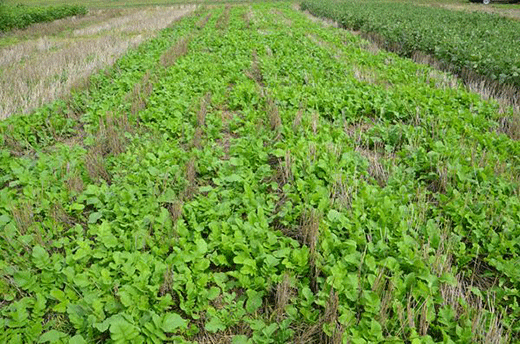
Planting cover crops is one management practice that can help reduce carbon emissions.
K-State researchers study benefits, risks of carbon credits
Agricultural economists say opportunities may be emerging for Kansas farmers
Sept. 20, 2021
MANHATTAN, Kan. – Kansas State University researchers have completed a study that looks at the potential value of carbon credits – and whether it’s an opportunity for farmers in Kansas to earn some extra income.
“There are starting to be a few more concrete opportunities for producers to sign up for carbon credits, and especially some opportunities in Kansas right now,” said Micah Cameron-Harp, who is a graduate student in agricultural economics.
Listen to an interview by Eric Atkinson with Micah Cameron-Harp and Nathan Hendricks on the weekday radio program, Agriculture Today
Carbon credits refer to a tradable permit or certificate that offsets the emission of one ton of carbon dioxide or another greenhouse gas by the credit holder. Large corporations – like McDonalds and Microsoft – have recently announced voluntary efforts to reduce carbon emissions by contributing to a carbon credit market.
“They’re making corporate pledges to reduce how much they’re emitting,” said K-State Research and Extension agricultural economist Nathan Hendricks. “They’re going to reduce their emissions, but in order to get to their goals, they’re going to buy some offsets. That’s what’s driving this market; it’s completely voluntary on the part of corporations.”
Agriculture is one of several industries that could benefit from the offsets sought by corporations. In effect, a farmer could be paid for implementing practices on their land that reduce carbon emissions.
“The most common (practices) that people talk about are no-till, and planting cover crops, but there are others out there,” Cameron-Harp said. “These are practices that sequester carbon from the air and store it in the soil in order to offset carbon emission from the corporations that are buying credits.”
Micah Cameron-Harp, a K-State graduate student involved in the study, said the university’s work was geared toward helping farmers better understand how to enter the carbon market. Cameron-Harp said researchers looked at what’s available and analyzed factors that should go into making a decision.
“We are taking this abstract marketplace where there are many players and distilling it down to what’s pertinent to a Kansas producer,” Cameron-Harp said.
Cameron-Harp said most buyers in the carbon market are paying $15 per carbon removal ton, and the price “is not fluctuating. Right now, there is not an interplay between supply and demand, so that is what you’re going to get at this point in time.”
“Ultimately, the goal is that this will become a free market,” Cameron-Harp said. “In such a case, we would see the price fluctuate as companies like Microsoft make large commitments. That’s what these marketplaces are hoping to achieve in the next couple years.”
In the European Union, buyers are paying as much as $55 per carbon removal ton, Cameron-Harp said.
“Something that would drive the price higher in the United States is if there was a point where some kind of regulatory pressure was put on companies to reduce their emissions,” Hendricks said, noting a carbon tax placed on businesses in the European Union. “If other companies had that, it would drive up the demand for how much they’re willing to pay for carbon credits.”
Farmers considering getting into the carbon credit should ask some key questions before signing a contract, including:
- How long of a commitment are you making?
- Is there a tenant-landlord relationship to consider?
- What data will you be required to provide?
- How will the buyer use the data you provide?
“There are a lot of factors to consider; it’s not just sign up for the highest payment and go with it,” Hendricks said. “You need to look at the data requirements for each place you go to, and each producer needs to use their best understanding of where this market is going to go.”
“It’s really important to look into each of the contracts and realize each of these is different and not just go for the highest price.”
Hendricks and Cameron-Harp recently presented their team’s findings at the K-State Risk and Profit conference in Manhattan. Their full presentation is online.

